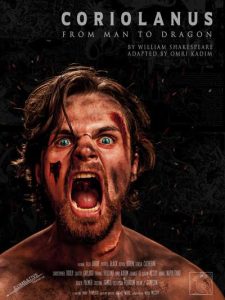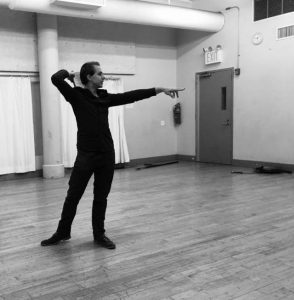
 When we think of Shakespeare, we often think of his mastery of the English language, his undeniable brilliance with words. The Combative Theatre Co., however, takes a different approach, focusing on stage combat as a storytelling method.
When we think of Shakespeare, we often think of his mastery of the English language, his undeniable brilliance with words. The Combative Theatre Co., however, takes a different approach, focusing on stage combat as a storytelling method.
Presented by Shakespeare in the Square, Combative Theatre’s production of Coriolanus brings the war back into the play. Moving away from just a focus on the politics of the show, their emphasis on stage combat and the physicality of the narrative brings a whole new level of action and excitement to the play that brings out the nuances of Shakespeare’s story. We caught up with director Yuriy Pavlish to find out more about the production.
How does stage combat figure into the show?
So this is a production of Coriolanus where we’re approaching the entire show through the perspective of how can we use language and what I call kinetic storytelling, or to stay it simply, staging, to reveal the story, and reveal what Shakespeare’s trying to say. A lot of time people have relied on using the words and finding different tones or different ways of delivering the words to make Shakespeare’s plays come alive. In reality, the best Shakespeare plays that you see are often good because they are marrying staging with those words. Where a person is standing, how they are relating themselves to their partner, and then they say the lines, and you’re like “oh my god, now I understand what this means.” So coming from that perspective, we’re taking what we see to be a very commonplace thing in the play of Coriolanus, which is combat, and really integrating that into the storytelling, and seeing if that allows us to understand the play better. And we’ve found that it really does. It really gives it an element that other productions of Coriolanus that I’ve seen didn’t exactly have.
How does stage combat affect the themes and story of the play, by having that as a primary focus?
We cut the play down to about an hour and 25 minutes, and we have between 20-30 minutes of stage combat in it. So a lot of what it does is it makes it into almost an action movie. You’ve got all the stage combat going on, which brings it away from what some people consider a stuffy play about politics. And it puts you in those people’s worlds, because the war is in the middle of the play. To be told that there was a war is one thing, but to see a very rigorous representation of that war, and what goes on, and how Coriolanus experiences that war versus how others experience that war, helps us make sense of why the characters act the way they do.
What goes into the choreography of a fight scene?
I’m here as a director, and my other half here is the fight director, Mitchell McCoy, and he’s amazing. The way I’ve seen him work, he’s similar to a dance choreographer, in that some of them will just show up to rehearsal, and they get a sense of what the scene should feel like, and then he kind of just in the moment comes up with what it should be. And then it’s just a matter of explaining it to his actors and working it out technically. That’s been a lot of what it is. We come into rehearsal, and we say, “Today we’re working the war.” In a very basic way, we storyboard it, the eight vignettes that should be a part of this war. And then we try it out. Most of the time, his first instinct is perfect and looks really good.

I imagine safety must be a huge concern. How do you keep that in mind?
There are all these tricks, it’s really funny. For example, when you swing a sword, you want to make it look like you’re really trying to hurt somebody and putting a lot of energy into it. The way that Mitchell teaches it is that you use all the parts of your body that have nothing to do with the sword. So your face, your voice, your feet – you tense them up and you make very swift motions with them, and it looks like you’re putting a lot of force into the sword, but then your hand is actually doing a very light swing. When done right, it looks like putting tons of power into this sword, but then the sword hits the shield with a little tap. It’s really amazing. That’s one of the techniques that Mitchell uses to ensure safety.
How do you find the right balance between words and action?
It’s often about watching the actors work through it. Oftentimes, if they get it, if they’re able to just look at the words, and automatically say them, and you see the story as it should be, and you don’t want to mess with that. The actor has found their connection to that character, so just make it rain. It’s when the actors are having trouble understanding, or it’s not really ringing true, oftentimes there, you’ll likely find what’s wrong is not that they don’t understand the text, but they’re not putting themselves in a position where their words will feel true to them, or to the audience, or to the other actor, because of the physical action. Patricia Black [who plays Volumnia] has this great monologue where she gives Coriolanus motherly advice. She’s saying don’t be true to yourself, because only by not being true to yourself will you achieve anything, because who you are is not fit for this country. It’s such an amazing monologue. And if she says it kind of standing across from him, that’s simple. But the way we’re doing it is, he has a weakness from the war, so she puts her hand on his shoulder and starts to dig in. Because she’s his mother, and he has to be respectful to her, he can’t fight back, so he sinks to the ground from the pain of this wound he received in the war. And her standing on top of him, that really brings out the intensity that she has.
We’re also approaching the play a bit from alternative staging. Usually you sit in the theater, but we’re not doing it exactly that same way. When you enter the theater, actually, most of the playing space will have no chairs, and the audience will be able to stand, and just be there. When the play starts, we’ll have the audience move around a little bit, and have them be part of the action. I won’t reveal exactly in what way, but there will be moments when the audience will be amidst in the action, when the action will be around them, and then other times we’ll give them seats midshow and go between sitting and standing. It’s an interesting perspective of the play around them. It’s really coming from the tradition of the groundlings. In Shakespeare’s times, you had people in seats, and those were people who gave more money or who were royals, and then the groundlings were the poorer people, and they stood. Seeing a play was kind of like a rock concert back then. So we’re trying to get at that. So of course we do have seating, for people who want to sit, but that’s going to be an interesting thing to see the play with, I’m very excited for that.
"Coriolanus: From Man to Dragon" plays November 4-20 at Italytime Theater.